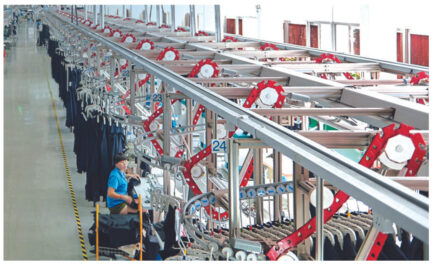 Japanese technology provider Konica Minolta has been included in 2023’s list of the World’s Top 100 Most Sustainable Corporations, from the Canada-based Corporate Knights. The company has also received a Gold-level recognition medal in this year’s EcoVadis Sustainability Ratings, and the 2023 Sustainable Yearbook by global market intelligence provider S&P Global listed Konica Minolta in the top 5 percent of the most sustainable companies in its industry. Mattia Perri, Inkjet Textile Sales Manager, Konica Minolta, said: “It is the 13th consecutive year Konica Minolta has been named in the sustainability yearbook, which demonstrates our commitment to the environment.”
Japanese technology provider Konica Minolta has been included in 2023’s list of the World’s Top 100 Most Sustainable Corporations, from the Canada-based Corporate Knights. The company has also received a Gold-level recognition medal in this year’s EcoVadis Sustainability Ratings, and the 2023 Sustainable Yearbook by global market intelligence provider S&P Global listed Konica Minolta in the top 5 percent of the most sustainable companies in its industry. Mattia Perri, Inkjet Textile Sales Manager, Konica Minolta, said: “It is the 13th consecutive year Konica Minolta has been named in the sustainability yearbook, which demonstrates our commitment to the environment.”
The company’s ITMA 2023 showcase focused on eco-friendly manufacturing resulted from those achievements. The company demonstrated its new AccurioTex700 solution. Sublimation printers reduce the amount of water and energy consumed in the digital textile printing process.
Many ITMA 2023 visitors are looking for solutions that streamline productivity, reduce lead times and cut costs. To meet this need, Konica Minolta also introduced the Nassenger 8 equipped with its in-line pretreatment technology for direct-to-fabric printing. The equipment minimises maintenance requirements which, the company said, reduces ink and fabric waste.
Perri added: “The entire textile industry is moving towards technologies that are as sustainable as possible. In order to facilitate this revolution, the tools used must be adequate. It is essential to have products that can safeguard the environment, but at the same time avoid lowering the quality standards of the production chain.
“We prioritised modularity when developing our technologies to respond to various needs. This enabled us to cater to all print volumes from small start-ups to more structured, industrial-grade operations.” The digital textile printing industry was once praised for being more sustainable than traditional analogue processes. But, since inkjet textile printing technology became commercially available two decades ago, some critics argue the sector has not done enough to reduce its environmental footprint.
Many commentators highlight ink chemistry as an environmental vulnerability, but Perri believes inks are just one part of a much larger process. “They are very important, but other points in the process can also be worked on. Our technologies, both new and old, aim to reduce water consumption and CO2 emissions along the entire production line,” he said.
Printing efficiencies
Konica Minolta has been emboldened by an uptick in demand for energy efficient technologies following the economic crisis. In response to soaring inflation, print service providers are examining novel techniques to reduce expenditure – many subsequent solutions benefit the environment.
The trade-off between cost, sustainability and performance was once a barrier to the implementation of greener technologies, but Perri believes these issues have been alleviated as a result of research and development and the economic crisis.
“If customers choose our solutions, it is because they want printers that are efficient, reliable and sustainable. More and more businesses are asking us about sustainability, including one of our most important collaborators,” he said.
Sustainability has been a prominent issue for many years. To instigate change, governments turn to legislation, and this has been happening more in recent years.
Perri said Konica Minolta complies with the strictest regulations and the growing demand for sustainable technology, which is not limited to advanced economies but is also coming from developing nations.
“It is not easy to change a long-established process. It can take decades before substantial improvements are achieved across an entire manufacturing industry,” he said.
“The small steps taken years ago are now leading to big environmental wins. Even those technologies that seemed ill-suited to their market segments are coming to fruition. Important steps have been taken and the market is changing, but more can always be done to reduce our environmental impact. We continue to make positive decisions as an industry and, over the next few years, we will realise their benefits.”

















